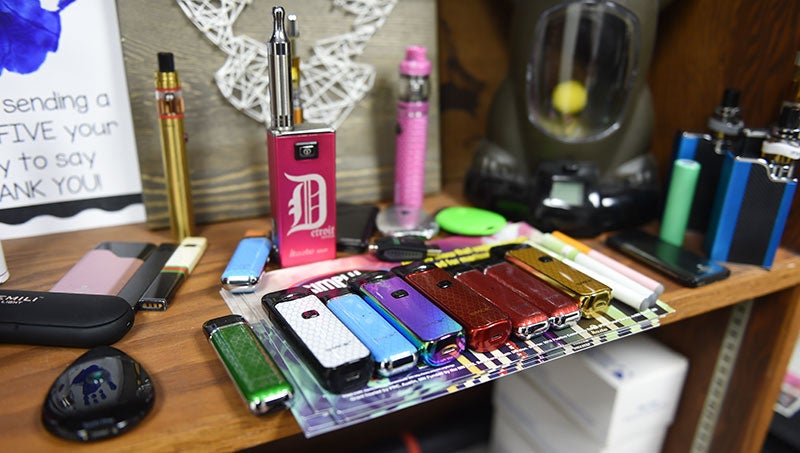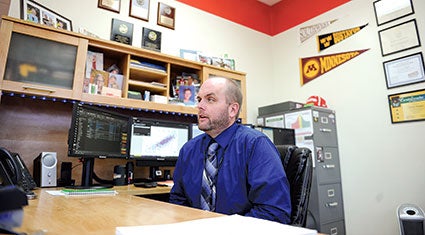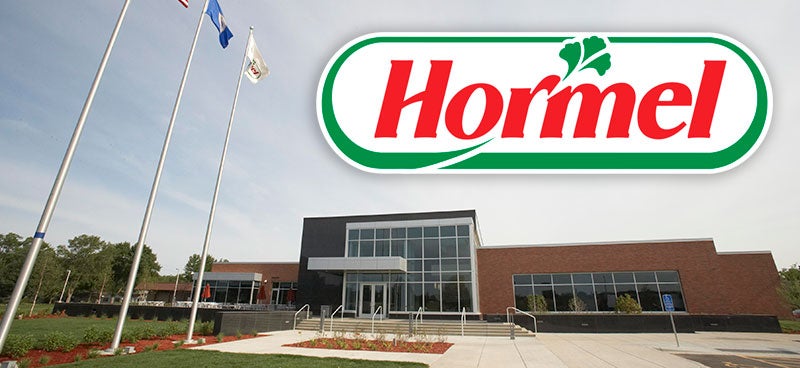State sees increase in students vaping; Austin Public Schools sees similar trends but paints a broader picture
Published 6:59 am Tuesday, October 29, 2019

- An example of the vaping devices confiscated from students at Austin High School. Results from a recent survey show that the majority of students in the district don’t vape. Herald file photo
Editor’s Note: This story is a continuation on the results of the 2019 Minnesota Student Survey, with this story focusing on the results involving vaping and student usage.
As vaping continues to swirl into relatively new territory concerning health and the increasing number of students statewide reporting that they’ve vaped, Austin Public Schools wants to bring another perspective into the conversation — The majority of the district’s students don’t vape.
Earlier this month, the results from the 2019 Minnesota Student Survey (MSS) were released by the Minnesota Department of Education (MDE) and the Minnesota Department of Health (MDH). A survey that has been given to students statewide since 1989, the questionnaire is administered every three years to collect responses from participating districts to understand what the health and well-being of Minnesota students looked like over the last 30 years, according to the MDE, and look into areas such as health and well-being, mental health, nutrition, relationships, substance abuse, bullying and school climate.
Worth noting was the inclusion of asking students whether they have used e-cigarettes or vaped within the last month. The survey responses showed that there were fewer students participating in risky behaviors like having sex, drinking and smoking marijuana, but there was a rise in the number of students reporting to have vaped within the last month. From the 2016 MSS, 17 percent of the state’s high school juniors reported that they vaped. For the 2019 survey, this number increased by 54 percent, and the number of eighth grade students vaping has also risen.
“Research tells us sleep, exercise, nutrition, mindfulness, a safe, nurturing environment and caring adults can help youth thrive, avoid risky behaviors like vaping and recover from toxic stress,” said Minnesota Health Commissioner Jan Malcolm. “We must focus on helping Minnesota’s kids in and outside of schools by strengthening the ability of families and communities to give our children the connections, support, stable environments and opportunities they need for a sense of well-being about their lives and futures.”
Most of Austin’s students not vaping
Austin Positive Action Coalition (APAC) is an entity that’s grant hosted by the Parenting Resource Center and funded by the Minnesota Department of Human Services, Alcohol and Drug Abuse Division. Members work together to reduce alcohol, tobacco and other drug use among peers by empowering and supporting each other to make healthy choices.

Bill Spitzer, Austin Positive Action Coalition,
Planning and Implementation Coordinator
Spearheading the initiative, Bill Spitzer, Planning and Implementation (PI) coordinator, said that APAC has been providing yearly surveys that document the students’ responses in how they view underage drinking and substance abuse. However, the point of the survey was to focus on what the majority of students are doing, as opposed to the minority.
Although APAC’s grant directive was to reduce underage alcohol and marijuana use in Austin, the increase in vaping was something that caught the committee’s eye. In 2019, Austin students took two different voluntary surveys that were analyzed by APAC as part of the five-year grant that was awarded to the community in 2016.
This Positive Community Norms (PCN) survey is the second in a series of three surveys being administered to students as part of the PI grant from the Minnesota Department of Human Services, Behavioral Health Division. About 83 percent of students took the survey voluntarily, or 1,670 students.
From the 2019 PCN data, 55 percent of students reported vaping marijuana. Austin High School students had a 12 percent increase in the use of vaping devices since 2017, but the numbers that Spitzer wanted the community to focus on was the other statistic: 78 percent of AHS students self-reported not using vaping devices compared with 90 percent of students reporting not having used in 2017.
Though the increase may be disconcerting to some, Spitzer was enthusiastic that majority of students in the district didn’t vape. Relying on a positive community norms messaging campaign that serves as a prevention strategy based on social norms theory, APAC focuses on messaging that corrects misconceptions about Austin’s youth and adults on underage drinking and other destructive behaviors. From PCN research, it found that perceptions held by students and communities determined whether there’d be more negative behavior.
“Our 2019 PCN data indicated a greater increase in high school use of vaping devices than middle school students,” Spitzer said. “APAC will continue to share that most high school and middle school students are not vaping. This message is very important as the student’s perception of use is the reverse of the student reported use of vaping devices.”
So far, APAC has been collaborating with Mower County Public Health and educating parents through conferences, meetings about the health effects of vaping and what signs to look out for. Within the next few weeks, parents and community members will have access to an infographic showing trends on vaping within Austin. Interpreters at the Parenting Resource Center have been translating vaping education materials and messages in other languages to reach non-English speaking families.
In November, APAC plans to launch a PCN message campaign at Ellis Middle School, AHS and Pacelli Catholic Schools. A prevention letter was made available to parents during the first week of school that encouraged them to talk to their children about vaping.
“APAC will continue the positive message campaigns that shares that most students don’t vape in our schools,” Spitzer said. “It is very important for students to know that incidents of vaping have increased within recent months, but the norm is clear. Most don’t vape.”
An ongoing conversation, not a new subject
School officials said that while the MSS did provide valuable information on the thoughts and feelings of students statewide, there were some discrepancies when it came to painting a more accurate picture of what the APS district was doing to curb these behaviors in comparison to the statewide trends.
Not dismissing the importance of the MSS, Corey Haugen, director of research evaluation and assessment, said that the survey would provide good benchmark data, but the collected information would most likely not be the most updated statistics by the time of the next survey since students would be done with school and will have moved onto the next grade, possibly changing some of their experiences.

Corey Haugen, APS director of research evaluation and assessment
“While the survey is a good benchmark, it doesn’t give you the full picture and only gives the pieces,” Haugen said. “Schools have already been talking about school safety and a number of agencies already participate outside of what the district is able to do. For us, APAC has been the forefront at addressing student health and issues they may be facing today.”
Agreeing with Haugen’s assessment, John Alberts, executive director for educational services, believed that the MSS also didn’t show the progress over time that the districts have been doing to curb unwanted behavior, as well as the work that multiple agencies were doing to address problems that students were facing.
“It’s not all of a sudden that we woke up one day realizing that something needed to be done about this,” Alberts said. “It has been an ongoing process and conversation that we’ve been having every year that looks at what’s happening in our schools, and what we can do to better support our students.”



